Kathleen Mary Quinlan (post 1930)
Continued from: Kathleen Mary Quinlan
The 1927 share purchase by Lamont, Corliss & Co., was followed by some substantial changes. In 1929, Kathleen Mary Quinlan began repackaging its entire product range. Lamont, Corliss had been working with the J. Walter Thompson Company to advertise Pond’s and this may be why Ellwood Whitney [1904-1992] of J. Walter Thompson was engaged to do the redesign.

Above: 1930 Kathleen Mary Quinlan in new packaging using a colour scheme of flame, black and opal with jars topped with black Bakelite caps. There are two different lipstick cases. The one on the right might be the flip-top case the company first introduced in 1924.
In 1934, Lamont, Corliss relocated to their headquarters to the 19th floor of the Western Union Building at 60 Hudson Street and the offices of Kathleen Mary Quinlan were moved there as well. This may have contributed to the decision by Quinlan’s husband, Drew Drees [1884-1972], to leave Kathleen Mary Quinlan in 1935. His replacement as vice-president was Charles Thomas Maeding [1896-1995].
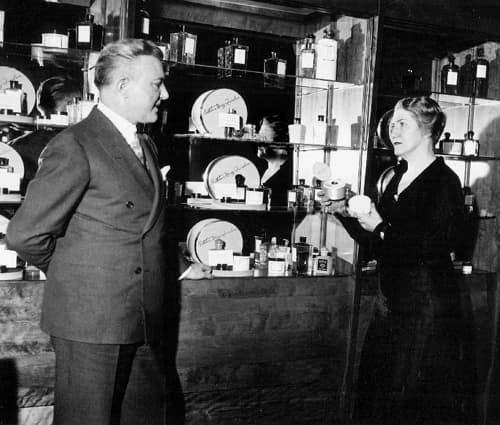
Above: 1934 Drew Drees and Kathleen Mary Quinlan in front of the display cabinet in the Buyers’ Room at 655 Fifth Avenue.
Drew’s exit does not appear to have been due to marriage difficulties as the couple were still listed as together in the 1940 census. After he left, Drees was employed by a number of other cosmetic firms including Imperial Salons, and Vadsco Sales (Delettrez), before becoming the sales manager for Antoine de Paris in 1939. He does not appear to have lasted long in any of these positions as he gave his occupation as unemployed when he filled in his 1942 Draft Registration Card.
At some point, Lamont, Corliss appears to have passed ownership of Kathleen Mary Quinlan to the Pond’s Extract Company, another company it controlled. Meanwhile, Quinlan appears to have become preoccupied with nutrition, writing a large number of newspaper articles on the subject between 1931 and 1938 mostly under the title ‘Foods favorable to beauty’.
Products
Along with the new packaging came a rationalisation of the Kathleen Mary Quinlan product line. Most of the hair-care lines seem to have been depreciated or discontinued except for the Quinlan Brilliantine, and the Vah-Dah products were renamed as Quinlan. On a more positive note, new skin-care and make-up cosmetics were introduced, the shade ranges of make-up were extended a little and the company introduced its first perfume, Rhythm, in 1936, followed by Organdy in 1937.
The initial product changes were overseen by Irvin Simpson Zeluff [1884-1965] who was hired as the company perfumer and cosmetic chemist in August, 1930. However, he appears to have left the company by 1933, well before Kathleen Mary Quinlan introduced its first perfume.
Some product adjustments made by Kathleen Mary Quinlan during the 1930s were responses to the worsening economic situation. Quinlan cosmetics were relatively expensive and positioned at the middle-to-upper end of the market where they came increasingly subjected to price competition as discretional spending declined. Kathleen Mary Quinlan tried to keep the prestige of the brand intact by introducing smaller, cheaper sizes for some of its products rather than lowering its prices. Starting in 1934, less expensive ‘travel’ sizes were gradually added to its inventory. Products included in this strategy included make-up such as Mist of Dawn and Poudre des Perles Face Powders as well as skin-care lines such as Persian Muscle Oil.
Skin-care
Kathleen Mary Quinlan renamed and/or reformulated sa number of its existing skin-care lines in the 1930s. For example, Camellia Cream appears to have been replaced by Quinlan Skin Youth Cream; Quinlan Skin Food by Quinlan Rich Tissue Cream, and Quinlan Persian Oil by Quinlan Persian Oil for the throat and neck.
Quinlan Skin Youth Cream: “An exquisitely light, non-fattening nourishing cream that keeps the skin smooth and velvety. Particularly recommended for the young girl; for the oily skin; for a plump well-rounded contour.”
Quinlan Rich Tissue Cream: “Thin, shrunken cheeks; tissues which show age and wrinkles—are nourished and brought back to a healthy, youthful condition by this preparation compounded of especially blended rich oils.”
Quinlan Persian Oil for throat and neck: “This stimulating, pungent throat oil … to tighten and strengthen sagging muscles and restore the contour of youth.”
In 1930, the company also made Quinlan Strawberry Cream Mask generally available, having previously been used exclusively in salon treatments along with a Special Heal Mask and a Herbal Face Mask. Later versions of the Strawberry Cream Mask are known to have contained the methyl salicylate and this, or natural wintergreen, may have been included in the original formulation. The mask proved to be popular and the company advertised it almost continuously from 1930 through to 1960.
Strawberry Cream Mask: “Applied before make-up and left on 20 minutes, it banishes signs of weariness, lightens and softens the skin, tightens muscles, leaves the complexion fresh and young as a Spring morning.”
Other changes saw Quinlan Cleansing Oil discontinued, Quinlan Skin Cleanser renamed/reformulated as Quinlan Liquid Cleanser and a new Quinlan Cleansing Cream introduced for dry skin types.
Quinlan Cleansing Cream: “[F]or a dry skin . . . The base of this preparation is a fine pure oil. This delicate cream liquifies the moment it touches your skin; it seeps deep into the pores, thoroughly cleansing them by brining all imbedded impurities to the surface of the skin.”
Quinlan Liquid Cleanser: “[S]pecially blended for oily skin, coarse pores and blackheads. It removes all accumulations and impurities from the pores and keeps them free from blackheads, and it modifies excessive action of the oil glands.”
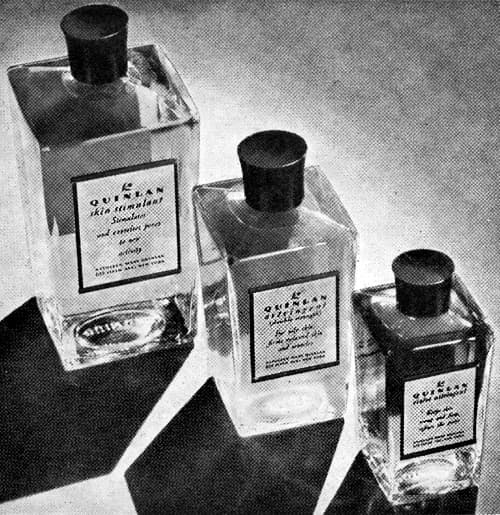
Above: 1935 Quinlan Skin Stimulant, Quinlan Astringent (Double Strength), and Quinlan Violet Astringent.
These alterations and additions meant that the Quinlan four-step routing for daily skin-care – Cleansing, Stimulating, Nourishing and Firming/Refining – now suggested using Quinlan Cleansing Cream, Quinlan Special Texture Cream, Quinlan Skin Stimulant, and Quinlan Violet Astringent if the skin was dry or Quinlan Liquid Cleanser, Quinlan Skin Stimulant, Quinlan Skin Youth Cream, and Quinlan Violet Astringent if the skin was oily.
See also: Kathleen Mary Quinlan advises (1935)
In 1930, the company began ‘simplifying’ some of its treatment regimes starting with a new Bleach Cream which replaced the previous two-step bleaching treatment which needed a cream and a lotion. The following year it started on its corrective treatments reducing their requirements to two preparations; another accomodation to the deepening economic depression.
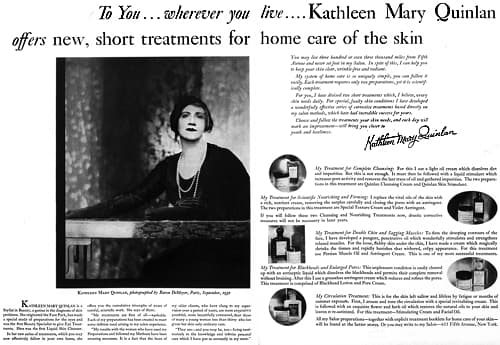
Above: 1931 Kathleen Mary Quinlan short treatments.
The recommended corrective preparations were as follows:
Double Chins, Sagging Muscles and Relaxed Contours: Quinlan Persian Oil for Throat and Neck, and Quinlan Astringent Cream.
Blackheads and Enlarged Pores: Quinlan Blackhead Lotion, and Quinlan Pore Cream.
Circulation Treatment: Quinlan Stimulating Cream, and Quinlan Facial Oil.
Acne Treatment: Quinlan Skin Ointment, and Quinlan Acne Lotion.
Quick Rejuvenation: Quinlan Strawberry Cream Mask, and Quinlan Facial Oil.
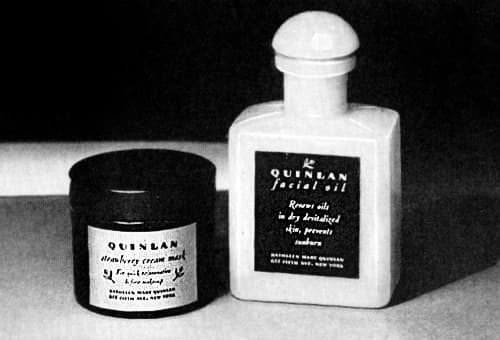
Above: 1935 Quinlan Strawberry Cream Mask, and Quinlan Facial Oil.
In 1936, Kathleen Mary Quinlan added three creams for super-sensitive, dry skin – Quinlan Special Formula Cleansing Cream, Quinlan Special Formula Tonic Lotion, and Quinlan Special Formula Tissue Cream. The last two lines were renamed as Quinlan Special Formula Lotion, and Quinlan Special Formula Emollient Cream after the passing of the Food Drug & Cosmetic Act (FD&CA) in 1938. The creams were introduced with advertisements warning of the dangers of asteatosis, the closest Kathleen Mary Quinlan came to using a scare campaign, a common practice in the 1930s.
Asteatosis is the technical term for an abnormally dry skin condition caused by a deficiency in oil secretion by the sebaceous glands of the skin. For the many w omen who suffer from this abnormally dry skin condition, Kathleen Mary Quinlan has created an original cosmetic treatment consisting of three simple but highly effective preparations—each a special formula for the treatment of the Super-Sensitive Dry Skin.
(Kathleen Mary Quinlan advertisement, 1936)
Later Special Formula lines included Quinlan Special Formula Face Powder (1937) and Quinlan Special Formula Toilet Soap (1938). These joined other new skin-care lines included Quinlan Dry Skin Cream (1936) for the body, Quinlan Throat and Neck Cream (1939), and Quinlan Softening Cream.
Quinlan Dry Skin Cream: “[H]as an almost magical effect on the skin of the hands, arms, elbows, knees, ankles and legs. Its simple use, faithfully followed, will bring you the rich reward of skin comfort and beauty.”
Quinlan Throat and Neck Cream: “[W]ill help retain young, firm beauty of your throat and neck lines.”
Quinlan Softening Cream: “For a normally dry skin. Use under your makeup to protect complexion”
Sun-care
Kathleen Mary Quinlan’s first sun-care line was Gitano Tan (1929). Quinlan Sunburn Cream in a tube and Quinlan Beach Oil in a bottle with a shaker top were added in 1935 followed by Quinlan Sunburn Lotion by 1937. The Sunburn Lotion was said to be protective so may have contained a chemical sunscreen.
Quinlan Sunburn Cream: “[I]f applied heavily will prevent a deep tan . . . it’s delightfully fragrant, soothing and greaseless—the ideal foundation for a sports make-up.”
Quinlan Beach Oil: “[A] rose-colored bio-chemical oil which is intended to prevent the discomfort of sunburn and windburn and promote an even tan.”
Quinlan Sunburn Lotion: “If your skin hat this protective care, you may have outdoor fun all summer and yet have that ‘natural look’ after sun and water bathing.”
Make-up
Kathleen Mary Quinlan had introduced a number of new compacts in 1930 and went on to repackage a number of other make-up items during the 1930s most of which had their shade ranges extended.
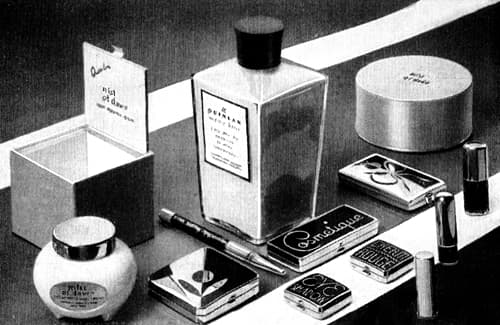
Above: 1935 Quinlan Make-up. The three lipstick cases appear to be from left to right – Evening, De Luxe, and Standard.
Foundations and powders
Kathleen Mary Quinlan started the decade with three cosmetics that could be used as a foundation – Mist of Dawn Beauty Cream, Mist of Dawn Vanishing Cream and Quinlan Skin Lotion – and two face powders – Quinlan Mist of Dawn Face Powder and Quinlan Poudre des Perles Face Powder.
During the early 1930s, Kathleen Mary Quinlan appears to have replaced/reformulated its existing foundations with Quinlan Make-up Lotion (1932) and Quinlan Mist of Dawn Liquid Finishing Cream (1934), with the recommendation that the Finishing Cream should be applied over the Make-up Lotion for evening make-ups.
Quinlan Make-up Lotion: “This fragrant lotion is so much more than a liquid powder base—try it, and know how smooth, fine-pored and clear your skin can look.” Shades: Flesh, Light Cream, Dark Cream, and Tan.
Quinlan Mist of Dawn Liquid Finishing Cream: “Will give your skin a youthful, pearly look that is flattering. Smooth it on your face and neck before make-up. Instantly your skin acquires an alluring, lasting finish . . . powder dabbing is ended . . . throat crepiness disappears!” Shades: Flesh, Cream, White, and Tan.
In 1940, Kathleen Mary Quinlan added Mist of Dawn Foundation Lotion for dry and sensitive skin in three shades increased to four by 1944.
Mist of Dawn Foundation Lotion: “A foundation that imparts to your skin the appearance of glowing youth . . . soft, smooth, fresh! Holds your powder and rouge with flattering delicacy for hours at a time.”
In 1931, Quinlan Poudre des Perles was repackaged in a round glass jar with a decorative engraved plastic top, and unusual design for this type of make-up. It was sold in a pink-lined, black box with a cover matched to the jar.

Above: 1931 Quinlan Poudre des Perles.
In addition to being over three times as expensive as Mist of Dawn, Poudre des Perles came in a wider shade range. Both powders came in Pearl, Flesh, Peach, Light Cream, Dark Cream, Rose Cream, and Sunburn Natural in the early 1930s but when Radiant Rachel, and Special Brunette were added in 1933, Poudre des Perles gained two extra evening shades – Mauve and Jade.
In 1937, Kathleen Mary Quinlan added a third face powder for super-sensitive dry skins in eight shades. As mentioned earlier this formed part of the special formula range which, collectively, might indicate that her clientele was ageing.
Special Formula Face Powder for super-sensitive dry skins: “Here is an entirely new kind of Face Powder—remarkably flattering, extraordinarily adherent, long-lasting, soothing and so fine it can be used safely on the driest and most sensitive skin. It contains no orris root is as non-allergenic as the Quinlan laboratory knows how to make it.”
Information of later Kathleen Mary Quinlan powder shades is generally missing but included Magenta (1938), and Royal Rage (1939) the later being a response to the visit by King George VI and Queen Elizabeth to New York in June, 1939.
Lipstick and rouge
In 1930, Kathleen Mary Quinlan only appears to have sold a lipstick in two shades – Light, and Dark with Medium introduced by 1935. In 1933, a new Evening Lipstick appeared, an indelible in Poinsette, Red Cherry, and Titian shades in case colours to match evening wear. Then, in 1935, Kathleen Mary Quinlan added De Luxe Lipstick, another indelible in Red Radiance, Poppy, and Tangerine in yet another case. A fourth case was added in 1937 when the company introduced its ivory lipstick cases with three-feathered crests and this also came in a gold-tone at a later date.
New lipstick shades were added through to 1941 – when the company was sold – included Copper Red; Petunia (1938); Royal Rage (1939); Blaze, and Heyday (1940); and New York (1941) but the list looks to be far from complete.
Kathleen Mary Quinlan continued to sell Liquid, Cream and Dry Rouges in the 1930s. In addition to new containers there were some additions to the shade range. By 1935 Medium had been added to the Cream Rouge – originally called Blush – and Poppy to the Dry Rouge. New shades added after 1935 tended to coincide with new tones added to lipsticks and face powders.
Eye make-up
Kathleen Mary Quinlan continued to promote her eye treatments – Quinlan Eye Bath, Quinlan Eye Cream, Quinlan Eye Astringent, Quinlan Eye Packs, and Quinlan Eyelash Cream – selling the products individually or in Eye Kits.
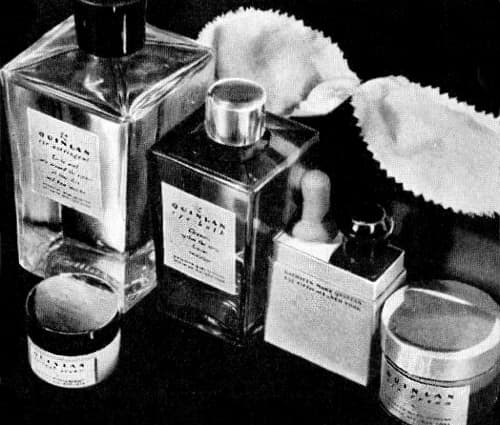
Above: 1935 Kathleen Mary Quinlan eye treatments.
The company also extended the shade ranges of its eye make-up adding Silver Green, Silver Blue, and Silver Mauve to Quinlan Eye Shadow in 1931. This cosmetic had the widest shade range of any Quinlan make-up cosmetic coming in Light Blue, Dark Blue, Gray Brown, Dark Brown, Dark Green, Light Green, Violet, Silver Blue, Silver Green, and Silver Mauve in 1934.
Quinlan Cosmetique (block mascara) also received new shades with Midnight blue (1931) and Green (1933) added to the existing Brown and Black. In 1941, the company added a cream mascara which it advertised as an eye shadow that could also be used on eyelashes when mascara was not being worn. It came in Blue, Green, and Orchid shades.
In 1938, Kathleen Mary Quinlan added a stick concealer, Quinlan Under Eye Pencil Pencil, in four shades sold in a lipstick case. It followed the introduction of Spot-Stik by Lydia O’Leary (1936), the first stick concealer, but Kathleen Mary Quinlan was one of the earliest companies to copy Spot-Stik, predating later entrants such as Helena Rubinstein’s Conceal (1942) and Max Factor’s Erace (1954).
Under Eye Pencil Pencil: “[U]sed to lighten under eye circles and to subdue superficial skin imperfections.”
See also: Covermark
Hands and nails
Kathleen Mary Quinlan sold a range of hand and nail preparations during the 1930s including Quinlan Cuticle Cream, Quinlan Cuticle Remover, Quinlan Nail Enamel and Remover, Quinlan Hand Cream and Quinlan Hand Lotion. The Hand Lotion and Hand Cream were available in the 1920s but I have no information on when the nail products were developed or on the shade ranges of the Nail Enamels.
War
America did not enter the Second World War until late, 1941, but the war in Europe created problems for the managers of American cosmetic companies well before that. Particularly affected were those relying on perfume imports from France such as Benson Storfer [1889-1970] of Parfums Corday. His supply problems would have consequences for Kathleen Mary Quinlan.
After founding Storfer Laboratories in 1925, Storfer had been the primary investor in Parfums Corday, Inc., a company established in New York in 1936 to take over the American agency of Parfums Corday (France) after Lionel Trading, the previous agent, got into financial difficulties.
In 1936, Storfer gained total control of Parfums Corday and prospects were good until the Second World War curtailed imports from France. Corday stocks became so scarce that Storfer had to ration supplies to his American stockists. He looked for an alternative range to fill the gap in his inventory which led to him purchase Kathleen Mary Quinlan in November, 1941.
Why Pond’s Extract decided to sell is unknown but industry insiders suggest that the management at Pond’s found it difficult to make and distribute a high-priced, low-volume line when for years they had been selling low-priced, high-volume cosmetics.
Just before they sold the company, Pond’s Extract had begun repackaging Kathleen Mary Quinlan in soft, feminine pinks.
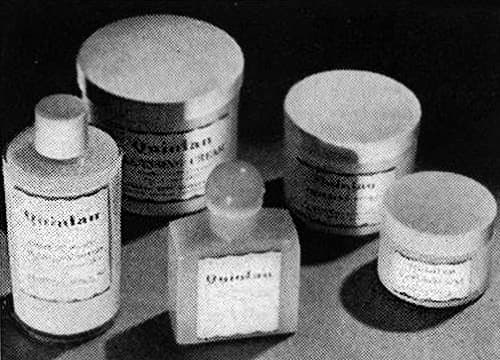
Above: 1941 Kathleen Mary Quinlan products in new packaging.
Following the purchase, Storfer moved Kathleen Mary Quinlan’s offices to 565 Fifth Avenue, the New York address for Parfums Corday.
Storfer’s involvement with Kathleen Mary Quinlan was generally positive with its sales doubling between 1941 and 1946 the year he sold the company. Wartime restrictions imposed limits on new product development but the company managed to add Forget-Me-Not Perfume (1942) to the other Forget-Me-Not lines and Mist of Dawn Leg Make-up (1943). The Heyday shade was also added to Quinlan foundations and face powders (1942), the Crushed Coral shade to Quinlan lipsticks, rouges and face powders (1943), and the Red Tape shade to Quinlan lipsticks and compact rouge (1945). During the war, Quinlan De Luxe lipsticks were sold in a new plastic case with the three-feathered crest while the standard sizes were encase in a pink plastic and paper container.
Post-war
In March, 1945, Storfer travelled to France to help reorganise the Corday factory in Paris so that it could resume shipments. Once these began to arrive, he no longer needed Kathleen Mary Quinlan to fill out his inventory and sold it to William Erhardt Weiss Jr. [1913-1885] in June, 1946. Weiss was the son of William Erhardt Weiss Sr. [1879-1942] one of the founders of Sterling Products. He had been the former president of Alba Pharmaceuticals and was also made the new president of Hirestra Laboratories in 1946.
Weiss placed Kathleen Mary Quinlan into Natcon Industries, headquartered at 487 Park Avenue but moved to 745 Fifth Avenue in 1951. It is possible that Quinlan may have retired in 1946. She had travelled with Storfer to France in 1945 so looks to have still been involved in the company until then.
After the sale Kathleen Mary Quinlan introduced a number of new lines including Precious Night Oils, Cream Cake Foundation, Complexion Wash and Suncloud (1946); Hormone Cream, and Hormone Oil (1950); and Roborare (1956) with and without hormones but removed others. For example, in 1948, it created a new Quinlan Face Powder to replace both Poudre des Perles and Mist of Dawn which were subsequently discontinued.
Precious Night Oils: “See how faithful use will help leave your skin wondrously soft, alluringly lovely and supple.”
Cream Cake Foundation: “[F}or the woman who dreams of a fresh, flawless complexion. Easy to apply . . . doesn’t cake or crack.” Shades: Rose Cream, Peach, Forget-Me-Not, and Heyday.
Complexion Wash: “[L]eaves your skin baby soft, deeply cleansed, refreshed. It’s a special joy if your skin is inclined to be oily.”
Suncloud: “[A] sunburn preventive that lets you tan to any shade you desire, is a beneficial skin beauty treatment as well. You get all the benefits of the sun without any damage to delicate skins.”
Lip Care: “[A] corrective for lips which show results of dehydration . . . a protective against sun . . . a preventive against cracking and blistering . . . a restorative that keeps lips soft, smooth, desirable.”
Hormone Cream: “Its base is rich, fresh, creamy . . . a Special Formula—perfected by Kathleen Mary Quinlan.”
Roborare: “[S]pecial deep-action fluid increases circulation, causing rich warm blood to flow swiftly to the skin surface. And stimulating vital moistures so that your skin fairly glows with the fresh clear look of youth.”
In 1950, some of these newer lines were combined with older products to form the Quin-Kit.
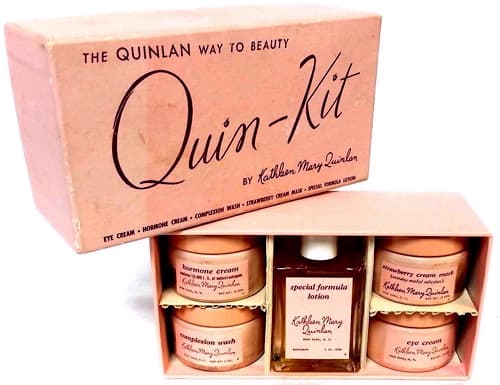
Above: Quin-Kit: Eye Cream, Hormone Cream, Complexion Wash, Strawberry Cream Mask, and Special formula Lotion.
Natcon Industries would eventually combine all of its Kathleen Mary Quinlan cosmetics under a Balanced Beauty logo and repackage them with a vintage double-pan scale on the label.
Balanced Beauty, a wonderful new method of skin care that encompasses far more than immediate results . . . that acts today, but thinks of tomorrow, guiding (not forcing) the delicate tissues of the skin to new perfection.
Balanced Beauty turns to the skin itself for inspiration, making use of natural forces deep within the tissues, reactivating the very mainsprings of beauty present in every individual. Nothing is ever left on the skin to cloud its natural radiance . . . applications never need to be “worked” in, rather, the skin is brought to function, for itself.
Balanced Beauty is created for the individual . . . not for “four common skin types” but for 9 particular, highly personalized skin categories.(Kathleen Mary Quinlan advertisement, 1955)
However, by the end of the decade Natcon Industries had sold Kathleen Mary Quinlan to Daggett & Ramsdell. Exactly when this happened is unknown to me but my best guess would be 1957 which is just before Daggett & Ramsdell merged with the Barcley Corset Company in 1958.
By 1959, Daggett & Ramsdell were advertising for women to sell Kathleen Mary Quinlan and Debutant cosmetics as well as Barclay bras and girdles and this may have been part of an attempt by Daggett & Ramsdell to set up its own door-to-door sales business along the lines of those run by Avon and Fuller Brush.
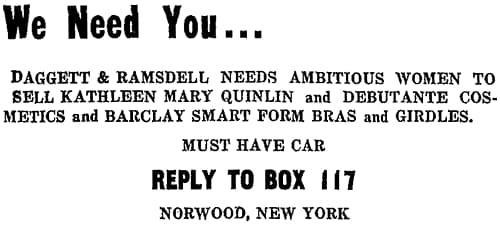
Above: 1959 Women wanted . . .
The attempt failed and Kathleen Mary Quinlan faded from existence in the 1960s.
Timeline
| 1930 | Line repackaged in flame, black and opal. New Products: Strawberry Cream Mask. |
| 1932 | New Products: Make-up Lotion; and Beach Oil. |
| 1934 | New Products: Mist of Dawn Liquid Finishing Cream; Flowers of Rain Bath Oil; and Verdant Pine Bath Oil. |
| 1936 | New Products: Special Formula Cleansing Cream; Special Formula Tonic Lotion; Special Formula Tissue Cream; Dry Skin Cream; and Rhythm Perfume. |
| 1937 | New Products: Sunburn Lotion. |
| 1938 | New Products: Special Formula Toilet Soap; and Under Eye Pencil. |
| 1939 | New Products: Throat and Neck Cream; and Foaming Bath Oil. |
| 1940 | New Products: Mist of Dawn Foundation Lotion. |
| 1941 | Acquired by Benson Storfer. Executive offices moved to 565 Fifth Avenue. Range repackaged in pink and magenta. |
| 1942 | New Products: Forget-Me-Not Perfume. |
| 1943 | New Products: Mist of Dawn Leg Make-up. |
| 1946 | Sold to William E. Weiss Jr. and placed in Natcon Industries, Inc. Salon moved to 487 Park Avenue. New Products: Cream Cake Foundation; Complexion Wash; and Precious Night Oils. |
| 1948 | New Products: Quinlan Face Powder. |
| 1950 | New Products: Hormone Cream and Oil. |
| 1951 | Natcon Industries moves to sales and showrooms to 745 Fifth Avenue. Manufacturing and executive offices move to Bethpage, Long Island. New Products: Balanced Beauty for the neck and throat. |
| 1954 | New Products: Roborare. |
| n.d. | Sold to Daggett & Ramsdell. |
First Posted: 6th April 2022
Sources
The American perfumer & essential oil review. (1906-1955). New York: Robbins Perfumer Co. [etc.].
The drug and cosmetic industry. (1932-1997). New York: Harcourt Brace Jovanovich [etc.].
Kathleen Mary Quinlan. (1930). Dry and Sensitive Skin—Requires Special Care [Booklet]. USA: Author.
Kathleen Mary Quinlan. (1935). Kathleen Mary Quinlan advises [Booklet]. USA: Author.
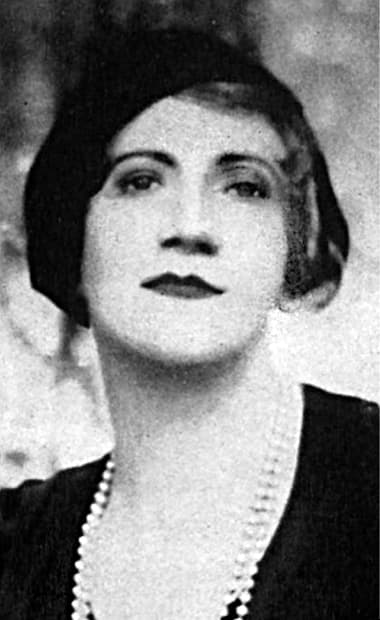
1931 Kathleen Mary Quinlan [1887-1957], a.k.a. Kathleen Mary Drews.
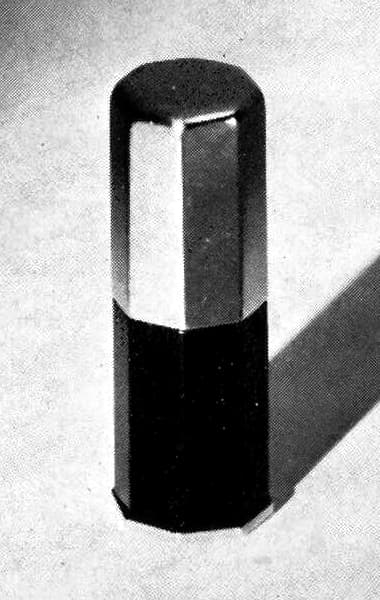
1931 Quinlan Lipstick. The case is very similar to Max Factor’s Super-Indelible Lipstick (1931).
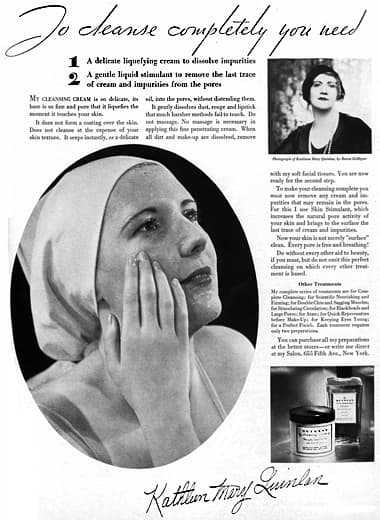
1932 Quinlan Skin Cleanser.
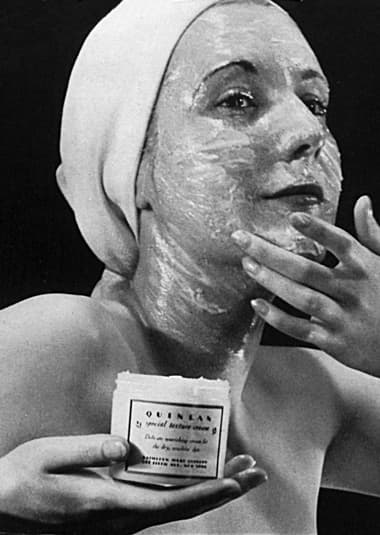
1932 Quinlan Special Texture Cream.
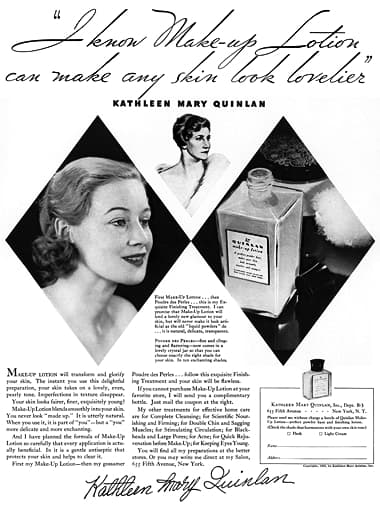
1932 Quinlan Make-up Lotion.
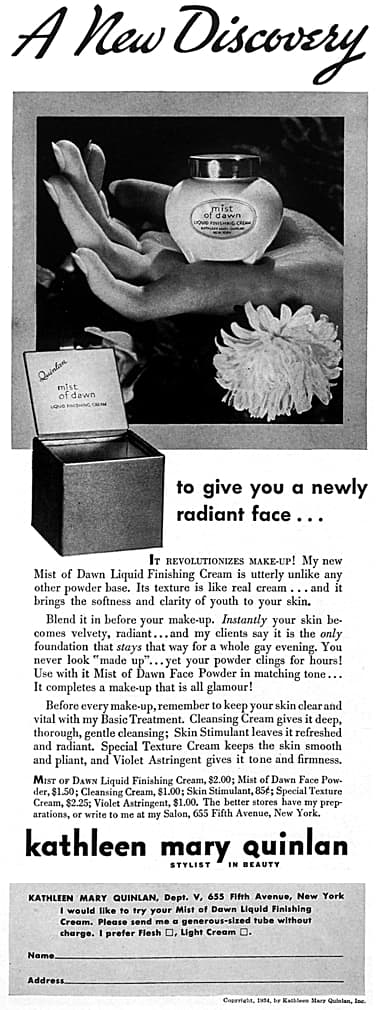
1934 Quinlan Mist of Dawn Liquid Finishing Cream in a three-legged opal glass jar, with a chrome metal lid and silver paper label, packaged in a pink box.

1934 Quinlan Make-up Box manufactured by the Karl Voss Corporation in New Jersey.
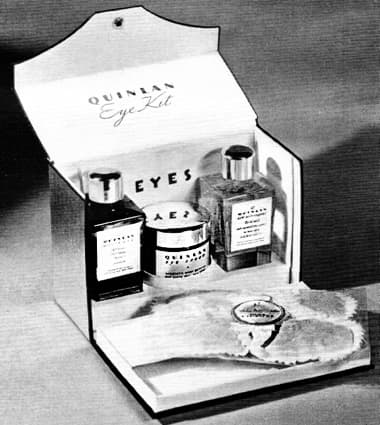
1934 Kathleen Mary Quinlan Eye Kit.

1935 Buyers’ Room at 655 Fifth Avenue with display cabinet on the left.
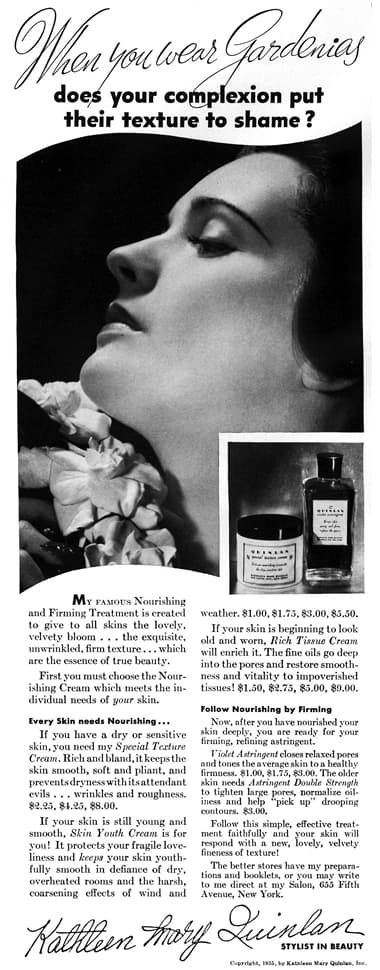
1935 Quinlan Nourishing and Firming Treatment with Quinlan Special Texture Cream and Quinlan Violet astringent.

1935 Kathleen Mary Quinlan Facial.
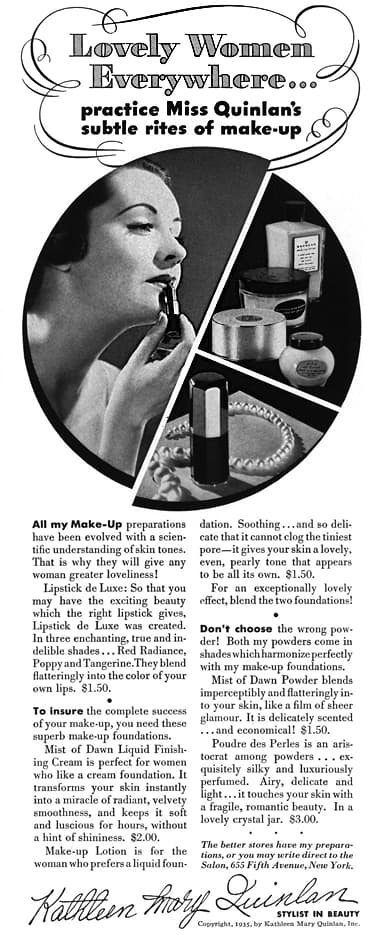
1935 Kathleen Mary Quinlan Make-up.
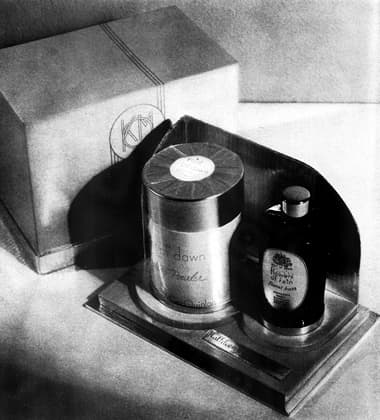
1935 Quinlan Bath Set. Mist of Dawn Dusting Powder (Flesh or Pink shades) and Flowers of Rain Eau de Cologne.
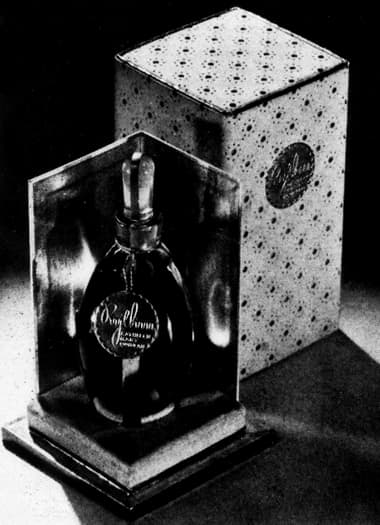
1936 Rhythm Perfume packaged in an oval bottle with a long glass stopper and gold label, boxed in a white and gold container.
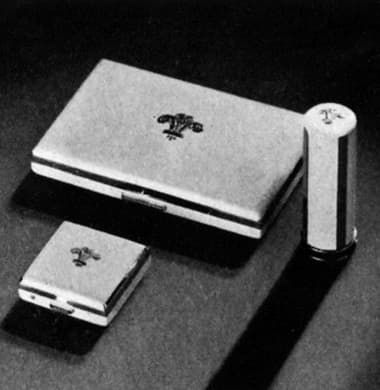
1937 Quinlan ivory compacts and lipstick cases with three-feathered crests. Earlier crested compacts had been produced in gold-tone and jet black version was introduced in 1938.
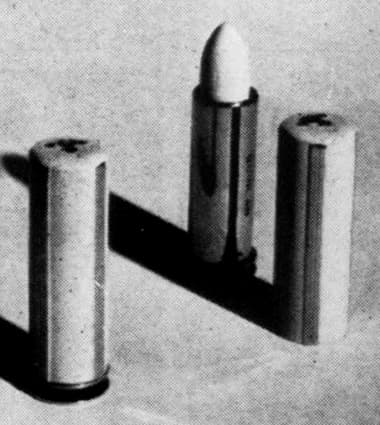
1938 Quinlan Under-Eye Pencil in an ivory lipstick case with crest.
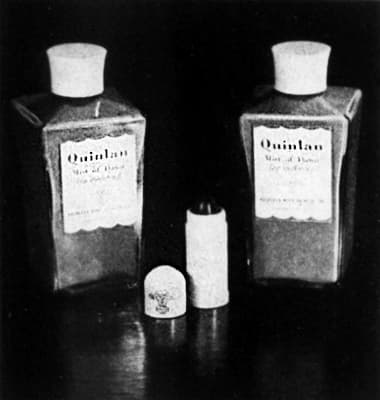
1943 Quinlan Mist of Dawn Leg Make-up in two shades and a Quinlan De Luxe Lipstick in plastic wartime packaging.
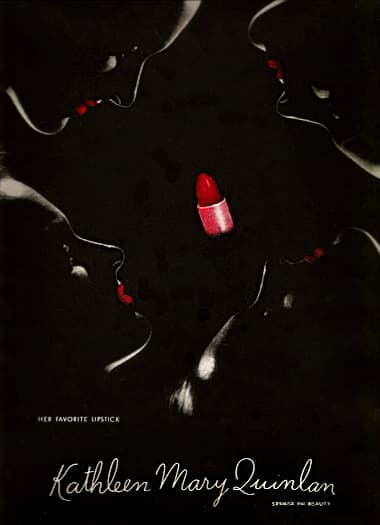
1943 Kathleen Mary Quinlan Lipstick.
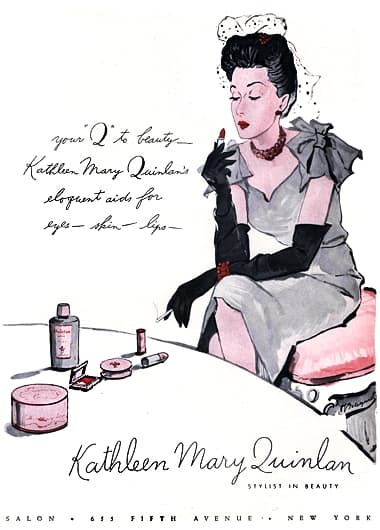
1943 Kathleen Mary Quinlan in new packaging.
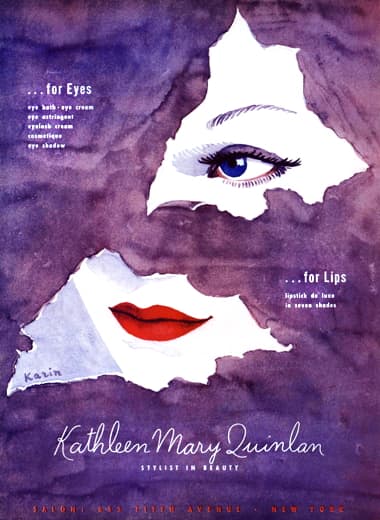
1944 Kathleen Mary Quinlan . . . for Eyes . . . for Lips.
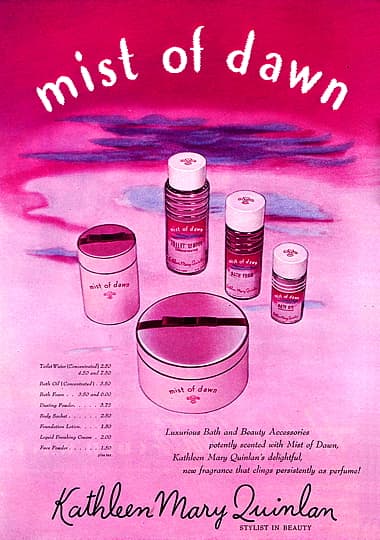
1945 Quinlan Mist of Dawn products.
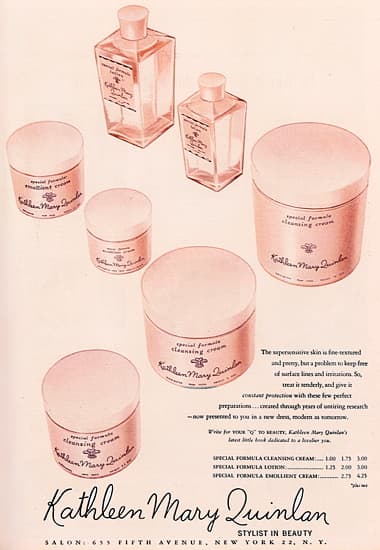
1945 Quinlan Special Formula Cleansing Cream, Quinlan Special Formula Lotion, and Quinlan Special Formula Emolient Cream.
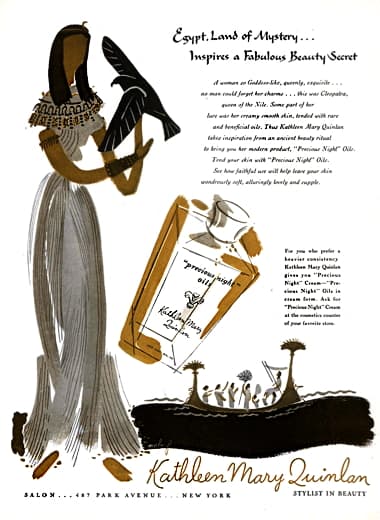
1946 Quinlan Precious Night Oils.
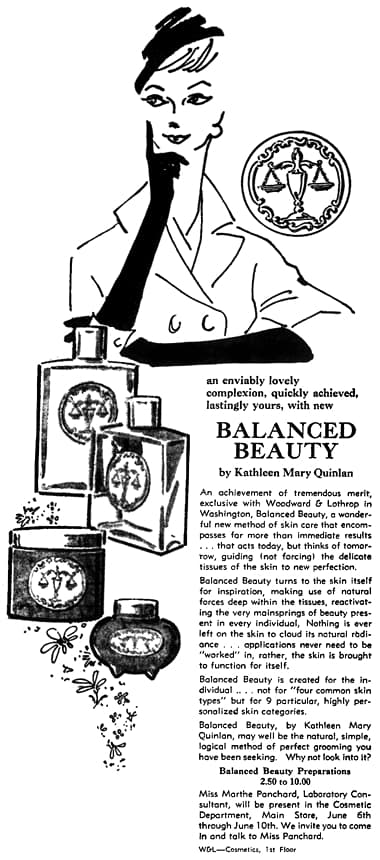
1955 Kathleen Mary Quinlan Balanced Beauty.
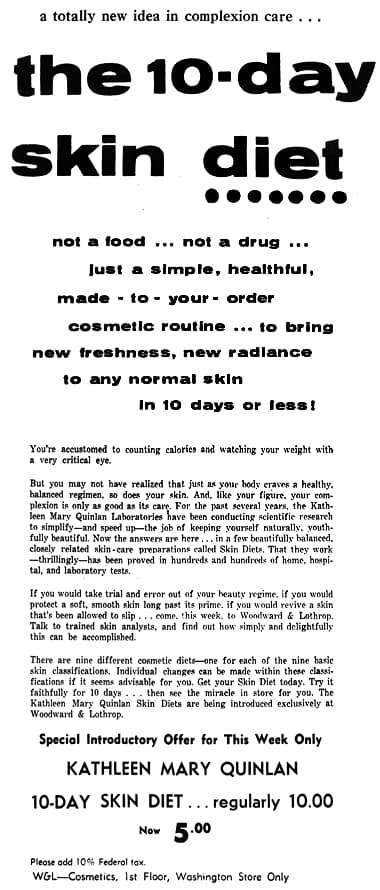
1956 Kathleen Mary Quinlan Skin Diet.
